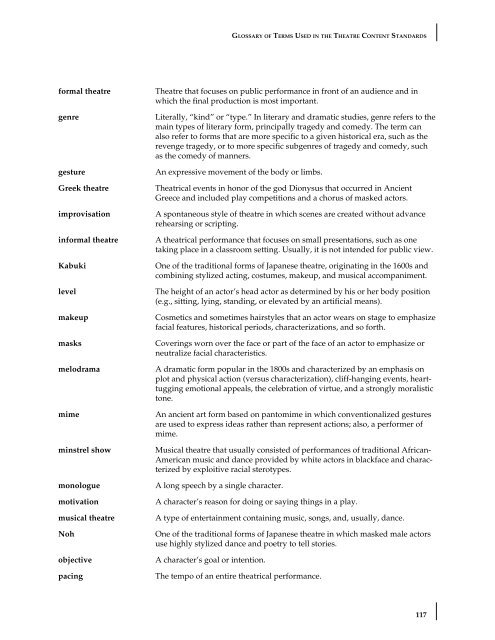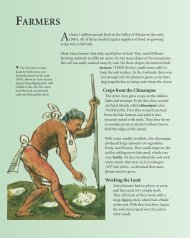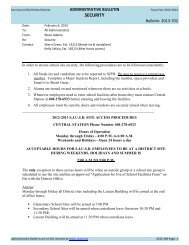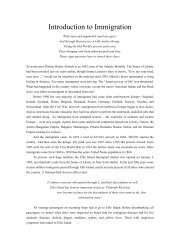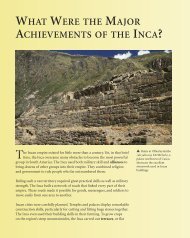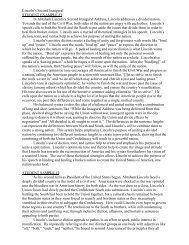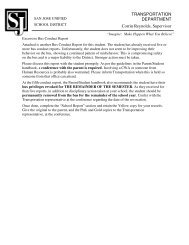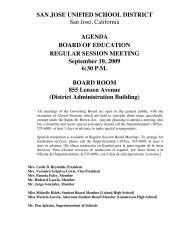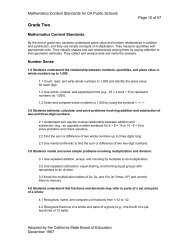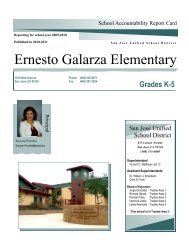Visual and Performing Arts Content Standards - California ...
Visual and Performing Arts Content Standards - California ...
Visual and Performing Arts Content Standards - California ...
Create successful ePaper yourself
Turn your PDF publications into a flip-book with our unique Google optimized e-Paper software.
GLOSSARY OF TERMS USED IN THE THEATRE CONTENT STANDARDS<br />
formal theatre Theatre that focuses on public performance in front of an audience <strong>and</strong> in<br />
which the final production is most important.<br />
genre Literally, “kind” or “type.” In literary <strong>and</strong> dramatic studies, genre refers to the<br />
main types of literary form, principally tragedy <strong>and</strong> comedy. The term can<br />
also refer to forms that are more specific to a given historical era, such as the<br />
revenge tragedy, or to more specific subgenres of tragedy <strong>and</strong> comedy, such<br />
as the comedy of manners.<br />
gesture An expressive movement of the body or limbs.<br />
Greek theatre Theatrical events in honor of the god Dionysus that occurred in Ancient<br />
Greece <strong>and</strong> included play competitions <strong>and</strong> a chorus of masked actors.<br />
improvisation A spontaneous style of theatre in which scenes are created without advance<br />
rehearsing or scripting.<br />
informal theatre A theatrical performance that focuses on small presentations, such as one<br />
taking place in a classroom setting. Usually, it is not intended for public view.<br />
Kabuki One of the traditional forms of Japanese theatre, originating in the 1600s <strong>and</strong><br />
combining stylized acting, costumes, makeup, <strong>and</strong> musical accompaniment.<br />
level The height of an actor’s head actor as determined by his or her body position<br />
(e.g., sitting, lying, st<strong>and</strong>ing, or elevated by an artificial means).<br />
makeup Cosmetics <strong>and</strong> sometimes hairstyles that an actor wears on stage to emphasize<br />
facial features, historical periods, characterizations, <strong>and</strong> so forth.<br />
masks Coverings worn over the face or part of the face of an actor to emphasize or<br />
neutralize facial characteristics.<br />
melodrama A dramatic form popular in the 1800s <strong>and</strong> characterized by an emphasis on<br />
plot <strong>and</strong> physical action (versus characterization), cliff-hanging events, hearttugging<br />
emotional appeals, the celebration of virtue, <strong>and</strong> a strongly moralistic<br />
tone.<br />
mime An ancient art form based on pantomime in which conventionalized gestures<br />
are used to express ideas rather than represent actions; also, a performer of<br />
mime.<br />
minstrel show Musical theatre that usually consisted of performances of traditional African-<br />
American music <strong>and</strong> dance provided by white actors in blackface <strong>and</strong> characterized<br />
by exploitive racial sterotypes.<br />
monologue A long speech by a single character.<br />
motivation A character’s reason for doing or saying things in a play.<br />
musical theatre A type of entertainment containing music, songs, <strong>and</strong>, usually, dance.<br />
Noh One of the traditional forms of Japanese theatre in which masked male actors<br />
use highly stylized dance <strong>and</strong> poetry to tell stories.<br />
objective A character’s goal or intention.<br />
pacing The tempo of an entire theatrical performance.<br />
117


